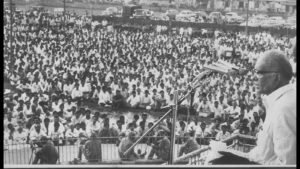
Donald Trump will walk into the Oval Office on January 20, 2025, with unprecedented political legitimacy. His decisive win in the electoral college, a sweep of all swing states, the support of a majority of Americans, the Republican capture of the Senate, the party’s possible win of the House, his authority over the ideological and organizational network of the Make America The Great Again (MAGA) movement, and the utter destruction of the political morale of American liberals and Left gives Trump political room to implement his vision.

But such a dramatic electoral win is only possible if it is based on an aggregation of interests, a coalition of groups, and a torrent of promises, all of which are sometimes at odds with each other. The test of a political campaign is in the ability to construct as wide a tent as possible to win the maximum number of votes, one that Trump passed spectacularly. The test of governance is in the ability to mediate between the conflicting interests that make up this tent, and factor in even those interests that may not be a part of it but are a part of the national tent. This is the test that Trump will embark on next January.
There are five tensions at the heart of the Trump project that span political economy, politics and foreign policy.
The first is between his promises of lower prices and higher tariffs. Trump’s solution for lower prices is more energy production; He claims this will lower gas prices. The economic applicability of this argument at this moment is suspect — the United States (US) is already seeing record levels of energy production; While gas prices contributed to inflation, it wasn’t the sole reason; inflation is dipping and the Fed is lowering interest rates. So, how he lowers prices further is one part of the puzzle. But the more perplexing part is how Trump will ensure prices don’t increase when he implements his other promise of higher across-the-board tariffs, with much higher duties for imports from China, as the key mechanism to bring back manufacturing in the US. and redress trade imbalances.
Besides the fact that this may potentially destroy a segment of American producers and exporters who will be subjected to retaliatory tariffs, the move has inflationary possibilities. America will continue to import what it needs in the absence of immediate local substitutes of the same quality and the same price range, and consumers will bear the burden. So the first tension that Trump has to resolve is how he increases tariffs — on what products, on which countries, to what degree — without it leading to higher prices, for that will erode the very basis of the mandate.
The second tension is between his promise to reduce prices and his proposed crackdown on immigration. With a mandate to deport those in America illegally, Trump’s border and immigration policy czars have the most extremist views of any set of officials since at least the 1965 Immigration Act, perhaps even since the century-old racist restrictions on the basis of national origin. The American political economy is complex. Yes, undocumented workers add to the burden on resources and generate a nationalist backlash, secure borders is common sense, and the scale of illegal immigration is staggering. But spend any time in cafes, on shop floors, at construction sites, on farms, and it is clear that immigrants, many of them without documents, run the economy. Despite that, employers complain of staffing shortages. Raiding workplaces and throwing those without adequate paperwork in detention camps may well hurt America’s smaller businesses, local industry and farm production. Besides the sheer scale of human rights abuse involved, the second tension Trump has to resolve is how he acts against undocumented workers contributing to America’s current economic activities, without leading to labor shortages, business shutdowns, and, possibly, inflation.
The third tension is between his large, and ever-increasing, working-class base and a smaller but influential clutch of fiscal conservatives and wealthy supporters. Trump has promised to reduce the deficit, cut taxes, and maintain big spending programs such as social security and Medicare. If he reverses tax cuts, the rich and corporates will be unhappy; if he cuts welfare programs, there will be a fierce middle-class and working-class backlash; and if he does neither, the deficit and national debt will increase, a sin in even MAGA fiscal circles. Trump’s answer to this trilemma is growth and reducing waste, but even this involves hard tradeoffs between various elements of his multiclass base.
The fourth tension is between Trump’s promise of ending wars with the specifics of geopolitical complexities in every theatre. Trump wants peace in Ukraine, but there is a trade-off between sustaining American credibility, maintaining European security, ensuring Ukrainian unity and getting Russian buy-in. Trump wants Israel’s triumph, normalization of relations between Israel and Saudi Arabia, Iran’s defeat and peace in West Asia. But there is a tension here between the motivations of Trump’s pro-Israel donors and Benjamin Netanyahu’s intent and actions in Gaza and West Bank, what Saudis need as a face-saver on Palestine to sign onto any normalization agreement, the expectations of Trump’s Arab- American supporters, and the security commitments required to take on Tehran. On China, there is possible tension between Trump’s national security hawks who want a competitive approach and his tech and business supporters who may want him to go easy in return for tactical concessions.
The final tension is reconciling the interests of his core White Christian nationalist base and his increasing base of supporters among minorities — Hispanics, Asian-Americans (including Indian-Americans), Arab-Americans, and even Blacks. White religious conservatives stuck to Trump even after 2020, for they saw in him a vehicle to deliver on their agenda just like he had done with abortion in the first term. But the more White and the more Christian Trump’s politics turns, the more difficult it will be for him to sustain the support of these newer groups which have given him a chance but remain largely uncomfortable with the religious and racial orientation of the party.
Elections are about sharpening contradictions. Trump is excellent at that. Governance is about reconciling them. Trump’s test on that begins now.
The views expressed are personal




